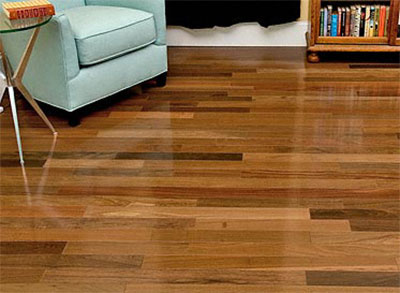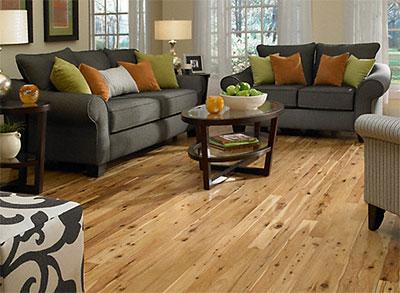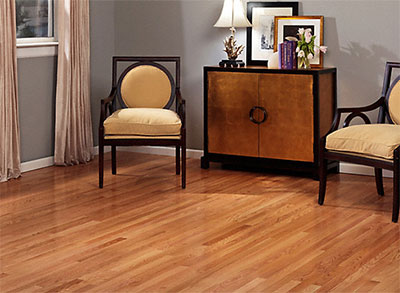Do You Want Unfinished or Prefinished Flooring?
by Rachel Lyon, Editorial Director for The House Designers®
To find the perfect flooring for your home, you need to take a number of characteristics into consideration. Is it the right color, does it have the right grain pattern, and can it hold up to wear and tear? There are so many options, it’s understandable if you have a hard time choosing! Before you get into the specifics, though, you should decide if you want unfinished or prefinished flooring. Both can give your home amazing floors, but each does have its benefits. Here’s how they stack up!
With a range of warm, earthy hues, this
R.L. Colston Brazilian Walnut flooring promises a unique look. It’s a beautiful and durable unfinished option.
The World of Possibilities
If you know one thing after a trip to your local flooring store, it’s that there are plenty of choices out there. Even just within the category of solid hardwood, you’ll find a range of colors from light to dark browns, a variety of red and gray tones, and uniform as well as high-contrast species. Add in straight versus swirling and knotted grain patterns and you might get overwhelmed by the style potential for your floors! For the most part, any of these looks is available in unfinished and prefinished forms, but there are some limits you should be aware of if you have your heart set on something specific.
Manufacturers produce prefinished flooring using wood from around the world. Whether you’re looking for a native North American species or an exotic one, you can probably find it in the prefinished section. On the other hand, the majority of unfinished flooring consists of wood that is local, although there are some exotic species to be found in some places. Also, if you are looking into a softwood like pine, you will almost certainly only find it unfinished. These floors might still come with tongue and groove planking for easy installation, but they will have raw surfaces for you to finish as you please. At the end of the day, that means practically limitless opportunity to create the floor of your dreams with stain, sealant, wax, etc.
Bellawood Natural Australian Cypress flooring is a high-contrast choice with a beautiful light base and dark, eye-catching knots. With a transferable 100-year warranty, you can be sure this floor is in it for the long haul.
The Convenience Factor
Many people go into the floor search with prefinishing at the top of their must-have list, and it’s little wonder why. Prefinished flooring comes fully treated with any staining done in a factory-controlled setting, so you know what the finished product looks like. It’s also cured for a stronger finish than you can produce at home, which better resists scratches and other signs of wear. But perhaps best of all, all of this translates into reduced installation time. Once the planks have acclimated to the space, they just need to be laid and nailed, glued, or floated. The floor can be fully installed and ready to live on in a day, so prefinished flooring is convenient whether you’re building a new house or doing a renovation.
The amount of processing involved in producing unfinished flooring is minimal. Logs are cut into planks and air or kiln dried, and that’s about it. To prevent damaging the floor through everyday use, it’s recommended that you finish it as soon as possible, and that takes a lot of time and planning. First, you need to sand, and take care to protect your vents, outlets, and self from the dust. If you’re using stain, each coat will require between two and ten hours to dry depending on the indoor climate and whether you’re using water- or oil-based stain. Multiple coats of stain are used to achieve a deeper and darker color, so that time can really add up. Polyurethane clear-coat, which is applied last for a durable finish, needs 24 hours to dry. During all of this time, you should arrange for other living accommodations. The process of finishing unfinished flooring can stretch out over days, so it doesn’t make for a quick job and it requires lots of preparation and patience.
This gorgeous
R.L. Colston Red Oak Select flooring proves that unfinished planks can become something special. As America’s most popular hardwood floor species, red oak is finished in all sorts of looks.
The Price Difference
At face value, unfinished flooring costs less than prefinished flooring, but you need to look at the whole picture to determine which is really the best deal. Prefinished planks come with a price that you can see, while unfinished ones are usually sold at a market price that fluctuates. The largest cost-determining variable, though, is labor. Many DIYers feel comfortable installing a prefinished floor because it’s straightforward, but homeowners also opt for professional installation that is completed quickly at a reasonable price. Finishing an unfinished floor is best left to experts because it is a challenging project, and the materials and labor really add up. The final cost can be significant, especially if you’re doing the whole house. And be sure to consider warranties as well—manufacturers back their prefinished products, but because the final quality of unfinished planks is out of their hands, they aren’t usually covered. With something as important as your floors, do the math early on to see what you can really afford and figure out how much a guarantee means to you.
Choosing unfinished planks can be a steal in some cases, too. If you love the rich reds of mahogany or the deep brown hues of ebony but don’t like the hefty price of exotic wood, staining another species to mimic the look is an option. Luckily, two of the most stainable species—red oak and white oak—are readily available in the unfinished flooring section, so you can personalize them to get the exact look you want. Mention your goals to the staff when you shop to ensure you choose the right species for your floor’s base—between undertones and grain patterns, you want to maximize the desired imitation.
If you’re ready to pick out gorgeous flooring for your home, or perhaps you need some more information, find your local Lumber Liquidators store. With plenty of unfinished and prefinished options and knowledgeable representatives to answer your questions in person and online, you’ll be well on your way to the perfect floor before long!



.png)
.png)




